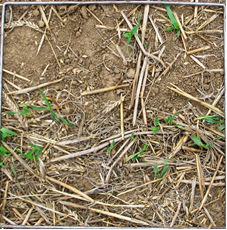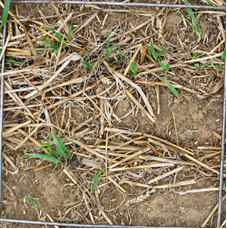Integrating livestock into cropping systems – using diverse feed sources to optimise profit
Author: Cam Nicholson, Nicon Rural Services | Date: 27 Feb 2018
Call to action / take home message
- The feed sources in a mixed farming operation (pasture, winter crops, stubble, summer fodder) are more variable than pasture and greater skill is required to match feed supply with animal demand.
- The pasture component in a crop rotation can be used successfully to control weeds, build nitrogen and improve soil conditions, but there are pitfalls.
- Mixed farming reduces downside risk compared to straight cropping, but usually lowers the chances of making very big profits.
- Integration and diversity created by mixed farming creates a level of complexity that requires sophisticated decision making to be successful.
Livestock numbers on farms in the traditional mixed farming areas of Australia have been in decline since the 1990s, although in the past few years these numbers have stabilised and are now on the increase (Bell et al, 2014). The reasons for the fall are a combination of commodity prices, the adoption of full stubble retention, operator frustration with the competition for time and resources between crop and livestock and the rapid technological advances in cropping compare to the animal system. However with major improvements in livestock and wool prices, a questioning of the no till means no livestock philosophy, the emerging challenges with weeds and organic matter decline and the desire by growers to increase on farm diversity to manage risk, means there is renewed interest in re-introducing or expanding livestock on grain farms.
Unfortunately decades of giving livestock the ‘poor cousin’ status has meant infrastructure has degraded or been removed and management skills lost with generational change. New knowledge created in the livestock industry in the past 20 years is unfamiliar to many growers and advisors. A 2013 survey of farm business operators showed not only their confidence in using the whole farm feed base was lower than their confidence with other practices such as stubble management, crop rotations and integrated weed management, but this has declined over the previous four years (Roberts, 2013).
The Grain and Graze program has been operating during this declining and now emerging resurgence in livestock, running from 2003 to 2016 across large parts of the mixed farming zones of Australia. The program started through a collaboration of the Grains Research and Development Corporation (GRDC), Meat and Livestock Australia, Australian Wool Innovation and the former Land and Water Australia. The second phase from 2009 to 2013 involved the GRDC in partnership with the Department of Agriculture and the final smaller extension phase just involved the GRDC (2014 to 2016).
This paper attempts to summarise the take home messages from growing and utilising various feed sources in a mixed farming system. It is not a complete summary of the work undertaken in Grain and Graze and readers are encouraged to visit the Grain and Graze website for more information.
Managing feed sources
Fortunately a lot is known about what animals need to reach certain levels of performance and the consequences if these benchmarks are not reached. Matching the right quantity and quality of feed to animal demand is an ongoing challenge even for single enterprise livestock graziers. In a mixed farming operation, there are different sources of varying quality and quantity feed at different times of the year (figure 1). Making best use of these different sources can be challenging because of the variability of feed quantity and quality.
Table 1. Likely availability of different feed sources during the year (X represents less reliability; Y represents more reliability).
Feed source | Availability | |||||||||||
|---|---|---|---|---|---|---|---|---|---|---|---|---|
J | F | M | A | M | J | J | A | S | O | N | D | |
Winter crops | X | X | Y | Y | X | |||||||
Crop stubbles | Y | Y | Y | X | X | |||||||
Winter fodders | X | Y | Y | Y | Y | Y | Y | Y | X | X | ||
Summer fodders | Y | Y | Y | X | ||||||||
Considerable work was undertaken in the Grain and Graze program to appreciate the opportunities presented by these additional feed sources and how they can be utilised while minimising any downside impacts.
Winter crops
One obvious feed source is winter crops, especially cereals. The decade of work in Grain and Graze on grazing winter crops is summarised in the Grazing Cropped Land booklet (Nicholson et al, 2016). Most work has been on cereals, especially wheat and barley. Information was collected on the dry matter production (table 1) at different times of sowing and the herbage quality (figure 2).
Table 2. Range in dry matter (kg/ha) for wheat and barley trials at different sowing times for low rainfall (n=48) and high rainfall (n=149) environments across Southern and Western Australia.
Rainfall zone | Crop | Time from sowing (weeks) | Dry matter (kg/ha) | ||
|---|---|---|---|---|---|
Average | Min | Max | |||
Low | Wheat | ~ 6 | 150 | 120 | 170 |
Barley | ~5 | 300 | 130 | 760 | |
Wheat | ~ 9 | 300 | 70 | 900 | |
Barley | ~8 | 600 | 220 | 1320 | |
High | Wheat | ~ 9 | 740 | 510 | 1310 |
Barley | ~9 | 1270 | 390 | 2440 | |
Canola | ~11 | 670 | 110 | 1490 | |
Wheat | ~ 12 | 1190 | 100 | 3410 | |
Barley | ~ 12 | 1490 | 170 | 2850 | |
Canola | ~14 | 1460 | 210 | 2450 | |
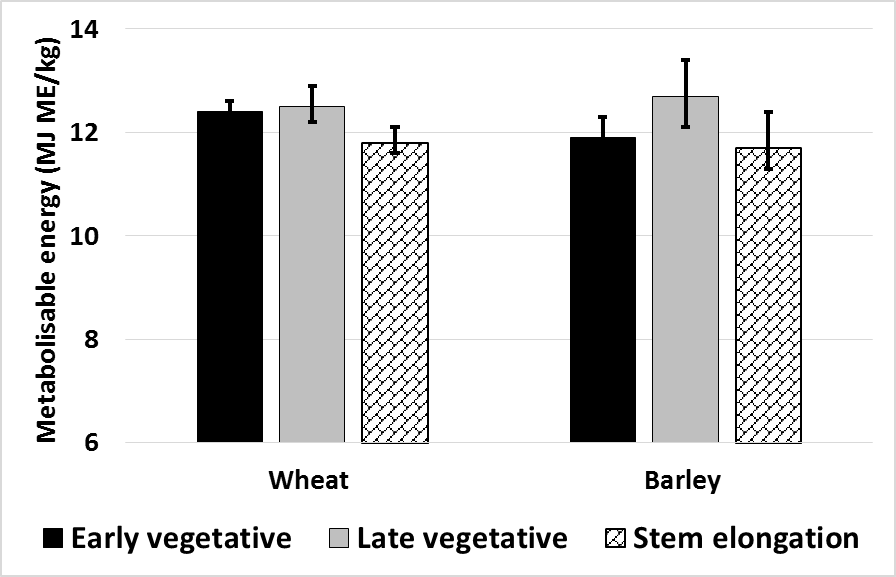
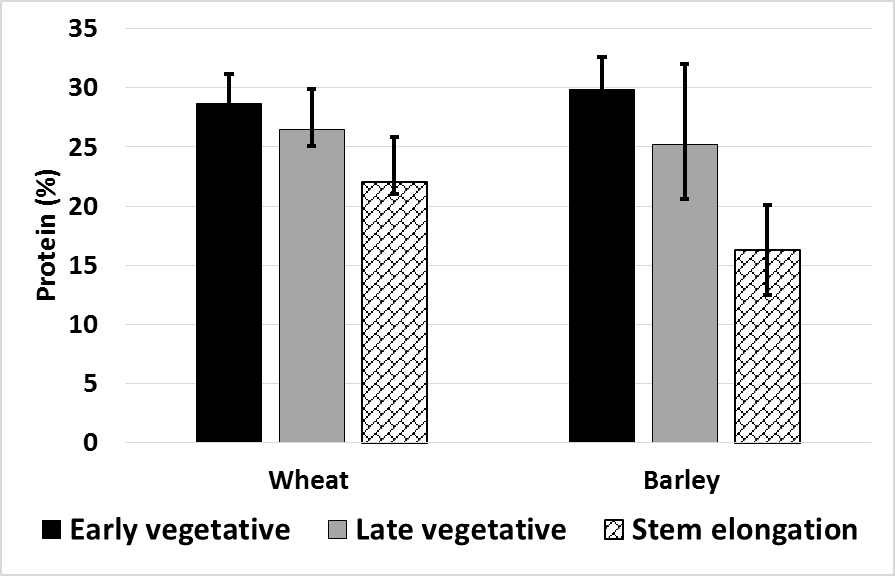
Figure 1. Range in metabolisable energy (top) and protein (bottom) for wheat and barley trials at different growth stages (n=125). Error bars is one standard deviation.
A common fear of growers and agronomists is the impact grazing may have on grain yield (Creelman et al, 2015). Measurements comparing grain yields with and without defoliation up to growth stage 30 over a 10 year period showed both decreases and increases in grain production (figure 2). These results were from multiple varieties, grazing regimes and sowing dates. A third of all measurements resulted in a small grain yield loss (< 250 kg/ha). Equally a third of measurements resulted in an increase in grain yield, primarily due to reductions in disease pressure and lodging.
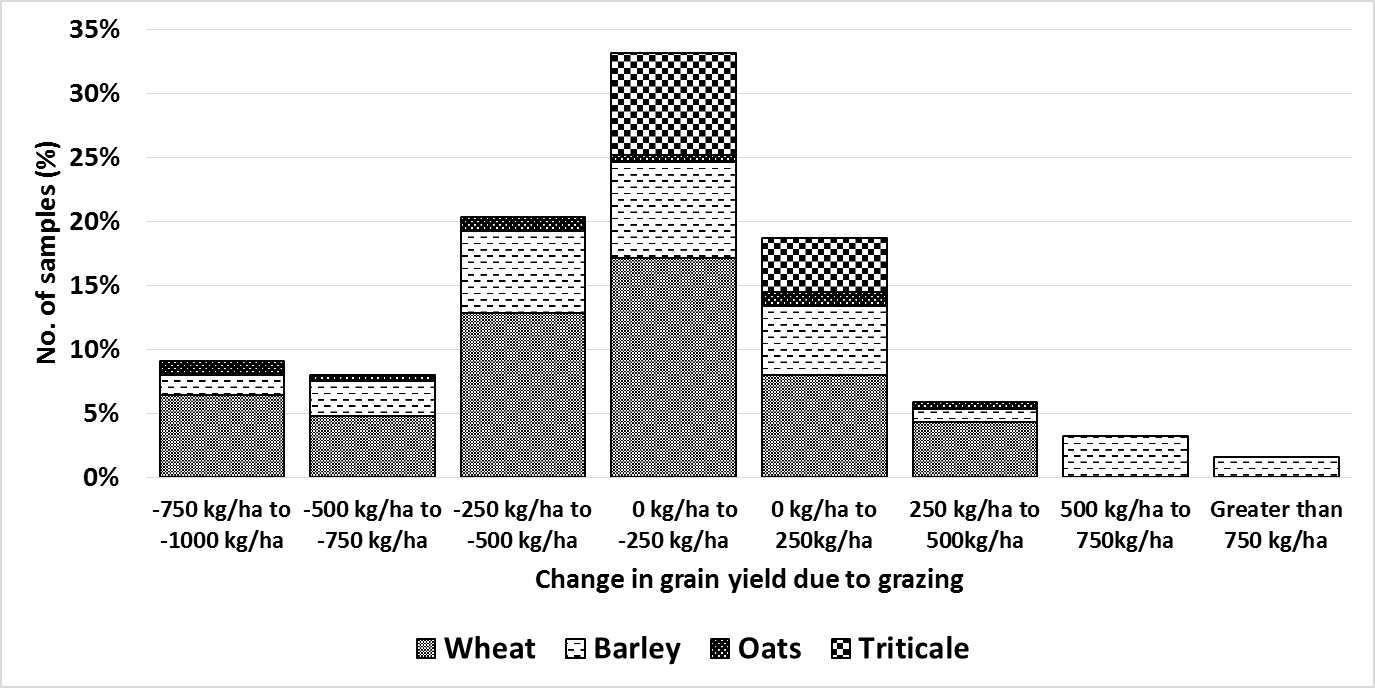
Figure 2. Change in cereal grain yield (kg/ha) due to grazing for wheat, barley, oats and triticale (n=187).
Multiple factors are believed to contribute to the range in responses including variety selection, crop growth stage and residual biomass left at the end of grazing, length of time between grazing and anthesis and post grazing conditions (moisture and heat). Key guidelines to emerge for grazing winter crops to minimise yield loss are presented (table 3).
Table 3. Key recommendations on grazing winter crops
Recommendation | Reasoning |
|---|---|
Sow winter varieties early (March - April), on opportunistic soil moisture | Earlier sowing increases likely dry matter production providing the opportunity for earlier grazing and longer periods of biomass recovery. |
Graze earlier (June/July) rather than later | The time and environmental conditions between the end of grazing and anthesis has a major influence on grain yield. The longer this recovery period the better. |
‘Clip graze’ in lower rainfall or moisture stress years | Retaining some leaf area reduces the amount of new biomass that needs to be regrown after grazing but before anthesis. |
Complete grazing before GS 30 | Grazing after GS 30 may remove elongating grain ears. |
Match variety to the growing environment | Grazing will also delay maturity and with long season varieties may expose ripening crops to heat and moisture stress. |
Other important findings from the grazing winter crop work include;
- Canola established at a ‘traditional’ late autumn sowing time and then grazed in winter commonly incurred significant yield losses compared to ungrazed canola. Early autumn, summer or even spring sowing appears to provide a more suitable dual purpose canola grazing opportunity.
- Stubble will be reduced after grazing, even when defoliated at the early vegetative growth stage.
- Grazing resulted in visual changes to the soil surface but no changes to subsequent water infiltration, soil water storage or crop yields. Grazed soils had a remarkable ability to ‘repair’ themselves.
- Grazing does not necessarily increase weeds, however weed free paddocks are the safest to graze. Experiments showed weeds increased, stayed the same or decreased as a result of grazing but there was no consistent reason for the change.
Crop stubbles
Winter crop stubbles can provide a valuable source of feed, primarily from residual grain and green shoots from shot grain and weeds. Standing straw and trash have much lower quality (energy and protein) which are below maintenance requirements for all classes of livestock. Therefore animal weight gain is directly linked to the amount of grain and green material in the stubble (assuming no supplementary feeding).
Improved efficiency of harvest machinery means not all crop paddocks have grazing value and only those with sufficient high energy material should be grazed, otherwise sowing and herbicide efficacy problems can be created with livestock laying over standing straw. Experiments indicate there needs to be at least 40 kg/ha of residual grain or 40 kg/ha of green material for a sheep to maintain or gain weight (although the gain is difficult to predict). Below these values animals lose weight, irrespective of how much straw or leaf trash remains.
A simple guide to help assess the amount of grain in a stubble is presented (table 4) along with photos of different levels of green materials (figure 3).
Table 4. Cereal grains and green shoots counts needed per 0.1 m2 to obtain 20, 40, 60 or 80kg residual grain or green material per hectare.
Number of cereal grains per 0.1 m2 and approx. quantity of grain/ha | Number of cereal green shoots per 0.1 m2 and approx. quantity of green/ha as dry matter | ||
|---|---|---|---|
Grains counted | Equivalent quantity of grain | Green shoots counted | Equivalent quantity of DM |
6 | 20 | 7 | 20 |
13 | 40 | 14 | 40 |
20 | 60 | 21 | 60 |
26 | 80 | 28 | 80 |
The equivalent of 40 kg/ha for crop legumes is approximately 4 grain per 0.1 m2 quadrant for lupins, 2 for field peas and chickpeas and 1 for faba beans.
|
|
|
40 kg/ha green (some shoots eaten) | 60 kg/ha green | 140 kg/ha green |
Figure 3. Visual indication of green shoot material available for grazing
Other critical points when grazing stubble;
- Grazing should be conducted to retain between 50% and 70% groundcover so as to avoid wind erosion or decrease water infiltration.
- In medium and low rainfall areas, removing green material in stubbles is recommended to conserve soil moisture, therefore only the residual grain should be considered as having grazing value.
Winter fodders
Unlike a ’grazing only’ situation, winter pastures in a cropping rotation are commonly grown for reasons other than just feed. Most commonly fodder are used to assist in weed control before the next cropping phase, to add biological nitrogen and to improve overall soil condition. Maximising fodder production for livestock is therefore only one of a number of possible objectives. When these objectives are combined with a farmer’s affinity towards and access to livestock, the fodder phase length they want, preparedness to resow each year and the potential ‘weed’ problem created in the subsequent crop, it creates a massive number of possible winter pasture options. There is no single ‘right’ answer.
The most suitable option needs to be formulated on a case by case basis, taking into account the relative importance of multiple objectives and other considerations described above. To assist with these considerations, the advantages and disadvantages for different legume and grass winter pastures tested in the Grain and Graze program are presented (tables 5 and 6).
Other key observations worth highlighting;
- There was a very large variability in overall fodder production from year to year. While annual production differences were anticipated because of seasons, the range was 0.5 to 12 t/ha. In general, grass fodder grew more dry matter of similar quality than legumes grown at the same time.
- Annual ryegrass can be dramatically reduced (to <10%) after 2 years of a pasture phase if seed set can be prevented. However it is essential to control late germinating annual ryegrass (October – November) that grows when applied herbicides are no longer effective. In contrast wild radish remains problematic, with no reduction in plant numbers recorded after many years of a fodder phase.
- Growing fodder legumes does not guarantee an accumulation of soil nitrogen and where accumulation does occur, it may be lower than the common rules of thumb of about 20 kg of shoot N/t dry matter (Peoples et al, 2013). Measurements of total soil nitrogen accumulation under legumes ranged from 0 to 150 kg/ha. There are multiple reasons why sub optimal fixation may occur (legume species, rhizobia efficiency, residual soil N) but one suggestion is the residual effect of common cropping herbicides, especially group B (Martin Barbetti, pers comm Nov 2016).
- Lucerne was the least beneficial fodder break crop in the 500mm+ rainfall areas because overall dry matter production was less than other fodder legumes, it captured most soil nitrogen so the next crop started from very low nitrogen levels and the release of organic nitrogen was much slower compared to other legumes (peaked around year 3). In addition, lucerne dried the soil profile more than other legumes which resulted in a greater soil moisture deficit if winter rainfall after removal was below average.
- Crops sown in years after a legume break that receive below average growing season rainfall can be oversupplied by the mineralised soil N, leading to higher screenings.
Table 5. Advantages and disadvantages of various fodder legumes
Attributes | Annual fodder legumes (arrow leaf, Persian, balansa, sub clover, medic) | Annual pulses (peas, beans) | Perennial legumes (lucerne) | |||
|---|---|---|---|---|---|---|
Advantages | Disadvantages | Advantages | Disadvantages | Advantages | Disadvantages | |
Feed quantity | Generally grows less dry matter than grasses | Generally grows more dry matter than fodder legumes | Out of season growth if summer rainfall occurs | Slow to establish and reach maximum production (usually year 2) | ||
Sub clover may grow less in first year while building the seed bank | Quick to establish and achieve ground cover | Annual production less than most other species | ||||
Winter growth may be slow especially if not sown early | ||||||
Feed quality for grazing | High quality feed when vegetative, usually better than grasses but not cereals or canola | Out of season high quality feed if rainfall occurs | Grazing lush lucerne can create digestive issues e.g. bloat, red gut | |||
Grazing | Provides in season grazing | Cannot be grazed in the vegetative stage | Can provides out of season grazing if rainfall occurs | |||
Seeding | Can sow same species year on year | May need to be re-sown each year - depending on species or if seed set is compromised by weed seed set control | Unable to sow same crop year on year | Only sown once | ||
Carry over seed / removal | May create a ‘weed’ problem when in the next cropping phase. | Unlikely to cause a ‘weed’ issue in subsequent crops | No carry over seed | Established lucerne can be hard to kill | ||
Disease break | Provides an effective grass disease break | Provides an effective grass disease break | Builds pulse disease population | Provides an effective grass disease break | ||
Nitrogen | Provides nitrogen but amount depends on effective nodulation | Unable to control mineralised nitrogen release | Provides nitrogen but amount depends on effective nodulation | Unable to control mineralised nitrogen release | Provides nitrogen but amount depends on effective nodulation | Very effective at scavenging any residual soil nitrogen |
Provide rapid mineralisation from dry mater | Provide rapid mineralisation from dry mater | Release of nitrogen over many (3+) years | No rapid release on nitrogen because of large tough roots that have to break down. Sub optimal soil N may occur in the first year after removal. | |||
Herbicides | Provides some alternative pre and post emergent herbicide options | Some herbicides may affect nitrogen fixation | Provides some alternative pre and post emergent herbicide options | Some herbicides may affect nitrogen fixation | Provides some alternative pre and post emergent herbicide options | Some herbicides may affect nitrogen fixation |
Green manure | Can be green or brown manured effectively | Can be green or brown manured effectively | Difficult to manure | |||
Fodder conservation | Higher quality fodder, usually of better quality than grasses or cereals | Limited fodder conservation options | Good quality fodder | |||
Post spring grazing | Nutritious carry over feed | Grazing can result in reduced ground cover | Nutritious carry over feed | Grazing can result in reduced ground cover | Retains quality late into the season. Possible regrowth if rainfall occurs out of season | |
Soil moisture | Dries soil profile similar to cereal crop | Dries soil profile similar to cereal crop | Dries soil profile more aggressively than other fodders, so may compromise stored soil moisture for the following crop | |||
Table 6. Advantages and disadvantages of various fodder cereals and grasses
Attributes | Annual grasses (annual ryegrass, oats, barley, wheat) | Perennial grasses (perennial ryegrass, phalaris) | ||
|---|---|---|---|---|
Advantages | Disadvantages | Advantages | Disadvantages | |
Feed quantity | Generally greater dry matter than legumes | Out of season feed if get summer rainfall | Slower to establish in first year with maximum production in years 2+ | |
Rapid early season dry matter (more than legumes) | Annual production similar to other species | |||
Rapid recovery after grazing | ||||
Feed quality | High quality feed when vegetative | Feed quality declines rapidly when plants become reproductive | Will provide some high quality green pick with out of season rainfall | Good quality feed when vegetative but usually less than other species |
Grazing | Provides early in season grazing | Provides whole season grazing | ||
Seeding | Need to be re-sown each year | Only sown once | ||
Carry over seed / removal | Any carry over seed likely to germinate early next season so easy to control | Any carry over seed likely to germinate early next season so easy to control | ||
Disease break | Provides a host to grass specific diseases | |||
Nitrogen | No nitrogen | No nitrogen | ||
Herbicides | Limited alternative pre and post emergent herbicides | Limited alternative pre and post emergent herbicides for other grasses | ||
Green manure | Can be manured | Difficult to manure | ||
Fodder conservation | Good quality fodder but usually poorer quality than legumes | Good quality fodder but usually poorer quality than legumes | ||
Post spring grazing | Limited carry over feed | Retains quality late into the season. Possible regrowth if rainfall occurs out of season | ||
Soil moisture | Dries soil profile similar to legume crop or typical crop rotation | Dries soil profile more than a legume crop or typical crop rotation but less than lucerne | ||
Summer fodders
Summer fodder crops have lost favour with many advisors and farmers in the Southern regions. The findings that retained soil moisture on fallows increases water use efficiency and that the gains in grain yield outweighed keeping the weeds for summer stock feed (Hunt, 2013) meant there was no incentive to include a summer water using plant. This thinking was widely adopted across Southern Australia, including the high rainfall zone. However work from Grain and Graze showed the need to conserve soil moisture was less applicable in areas of higher winter rainfall. In these areas the soil type results in high evaporative losses of soil moisture over summer through capillary rise, even without any plants actively growing and with reasonable amounts of retained stubble (approximately 4 t/ha). In addition, the limited water holding capacity of most soils in the high rainfall zone (HRZ) combined with the high probability of winter rainfall exceeding the soil water holding capacity, meant stored summer rainfall was of limited value to the next winter crop and in some cases led to more rapid waterlogging the next winter (Creelman, 2016).
Eight trials in the HRZ clearly illustrated there was no impact of growing a summer fodder for grazing on the subsequent winter crop, although grazing did significantly reduce the available soil nitrogen at the time the winter crop was sown (Nicholson, 2015).
These insights, combined with the release of canola with a strong vernalisation requirement, enabled out of season sowing of a brassica to be used for grazing over summer, followed by locking up the grazed plants to take through as a traditional winter crop for harvest. The quality of the canola dry matter was comparable to other fodder brassicas, with dry matter typically between 0.5 t/ha and 4 t/ha depending on summer rainfall. Subsequent grain yields have proved equal if not better than ungrazed canola sown in late autumn (GRDC, 2016). Significantly earlier sowing of wheat with strong vernalisation requirements is also being tried.
The long term disease, nitrogen and weed implications still need to be understood, however the approach provides an exciting way to change the thinking of utilising a dual purpose crop.
Conclusion
A lot has been learnt in the Grain and Graze program about the feed base opportunities arising from running livestock in a cropping operation. There are many potential benefits but to realise these will require changes to the way we think about livestock (class of animals, ownership models, essential infrastructure) and the cropping operation (what and when to sow, when to graze and how to include fodders in a rotation). These are complex decisions.
Useful resources
Grain and Graze website, an archive of all publications, tools and resources from the program since 2003.
References
Bell LW, Hayes RC, Pembleton KG, Waters CM (2014). Opportunities and challenges in Australian grasslands: pathways to achieve future sustainability and productivity imperatives. Crop and Pasture Science 65, 489-507.
Creelman Z, Falkiner S, Nicholson C (2015). Investigating farmer practices and concerns around grazing crops in south-eastern Australia.
Creelman Z (2016). Resource manual examining the rainfall and soil water probabilities at locations in southern Victoria.
Hunt J (2013). Control summer weeds to reap yield benefits.
Nicholson C (2015). Stored water, summer rainfall and the impact of summer fodders.
Nicholson C, Frischke A, Barrett-Leonard P (2016). Grazing Cropped Land: A summary of the latest information on grazing winter crops from the Grain and Graze program. GRDC Canberra.
Peoples M, Brockwell J, Swan A, Hayes R, Li G, Hackney B, Fillery. Factors affecting N2 fixation by pasture legumes.
Roberts (2013). Grain and Graze 2 Impact Report.
Acknowledgements
The findings in this paper are the result of many years of research and investigation by a lot of people involved in the Grain and Graze program from 2003 to 2013. There are too many people to mention. However the program would not have been possible without the significant and ongoing contributions of growers through the long term support of the GRDC.
Contact details
Cam Nicholson
Nicon Rural Services
32 Stevens Street, Queenscliff Vic 3225
Mb: 0417 311 098
Email: cam@niconrural.com.au
GRDC Project Code: SFS00028,
Was this page helpful?
YOUR FEEDBACK

